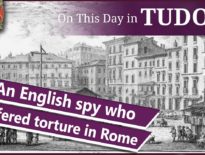On this day in Tudor history, 16th October 1532, while Henry VIII and Anne Boleyn, Marquess of Pembroke, were on their visit to Calais, English nobles met French nobles to arrange a meeting between the King of England and his French counterpart, King Francis I.
In today's talk, I give details on this event, who was there, what happened, and why Henry VIII and Anne Boleyn had gone to Calais.
Also on this day in Tudor history, 16th October 1555, in the reign of Queen Mary I, Protestants Hugh Latimer and Nicholas Ridley were burned at the stake in Oxford for heresy. Along with Archbishop Thomas Cranmer, they have become known as the Oxford Martyrs.
Find out more about these men and hear an account of their burnings – warning, it’s horrible – in last year’s video:
Also on this day in history:
- 1573 – Death of Thomas Davies, Bishop of St Asaph, at Abergele in Denbighshire.
- 1594 – Death of Cardinal William Allen at his home in the via Monserrato, Rome, while in exile. He was buried in Rome, in the English College's Church.
Transcript:
On this day in Tudor history, 16th October 1532, while King Henry VIII and his sweetheart, Anne Boleyn, Marquess of Pembroke, were lodged in Calais, Anne’s uncle, Thomas Howard, 3rd Duke of Norfolk, and a group of nobles and gentleman met with their French counterparts just outside of Calais. Wynkyn de Worde records this meeting in his contemporary pamphlet “The Maner of the tryumphe of Caleys and Bulleyn”, writing:
“And on the xvi. day of October my lord of Norfolk accompanied with my lord of Derby and a great number of gentlemen besides, met with the great master of France vi miles from Calais at the English Pale, the said great master having two great lords in his company of their order and a hundred gentlemen attending upon them. And there my lord of Norfolk and the great master devised the place where the two kings should meet, which was at Sandingfield. And that done, they went both to Calais with their companies. And the said great master with diverse other strangers dined that day with the king.”
Chronicler Edward Hall gives a slightly different account and dates the meeting to 15th October, writing:
“Suddenly came a messenger and reported that the Great Master of France, and the Archbishop of Rouen, with diverse noblemen of France, were come to Sandingfield, intending to come to Calais, to salute the king, from the king their master. He being thereof advertised, sent in great haste the xv day of October, the Duke of Norfolk, the Marquess of Exeter, the Earls of Oxford, Derby and Rutland, the Lord Sandys and the Lord Fitzwater, with 300 gentlemen, which honourably received the French lords at the English Pale, and so brought them to the king’s presence in Calais, which stood under a rich cloth of estate of such value that they much mused of the riches. The king (as he that knew all honour and nurture) received the French lords very lovingly and amiably, and with them took a day and place of meeting. These lords were highly feasted and after dinner departed to Boulogne.”
Whatever the date of this meeting between the Duke of Norfolk and English nobles and gentlemen and Anne, duc de Montmorency, Grand Master of France, and French nobles, the purpose of the meeting and the French party’s visit to Calais, was to arrange a meeting between the two kings, King Henry VIII and King Francis I. Sandingfield was chosen as the meeting place. It was convenient in that it was in the English Pale, situated between Calais, the English territory where Henry VIII was staying, and Boulogne, where Francis I was with the French court. You may not have heard of Sandingfield and that’s because it’s now called Saint- Inglevert.
The two kings did indeed meet at Sandingfield on 21st October 1532 and Francis then took the English king back to Boulogne, where they remained until 25th October, when they and their parties travelled to Calais for Henry VIII to play host.
As I explained in my talk on 11th October, the purpose of Henry VIII’s visit to Calais was to meet with King Francis I and to obtain his support for the annulment of his marriage to Catherine of Aragon and his plan to marry Anne Boleyn. Anne had accompanied the king on this trip and Henry had recently made her Marquess of Pembroke to make her a fitting consort. The trip was a successful one with Francis I pledging his support.
By the way, you may be thinking that I made a mistake with the Grand Master of France’s name, Anne, duc de Montmorency. Well, I didn’t. His name was Anne and there have been lots of male Annes in French history, and also Dutch history. Other French Annes in history include Anne de Joyeuse, a 16th century French admiral, and Anne d'Escars de Givry, the 16th century French cardinal. Then, in Scottish history, we have 18th century nobleman Lord Anne Hamilton. So it’s not just a girl’s name!



Leave a Reply